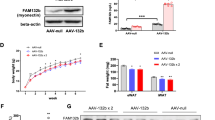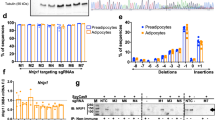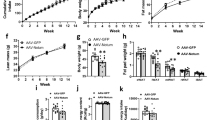Abstract
Adipose tissue has a critical role in energy and metabolic homeostasis, but it is challenging to adapt techniques to modulate adipose function in vivo. Here we develop an in vivo, systemic method of gene transfer specifically targeting adipose tissue using adeno-associated virus (AAV) vectors. We constructed AAV vectors containing cytomegalovirus promoter-regulated reporter genes, intravenously injected adult mice with vectors using multiple AAV serotypes, and determined that AAV2/8 best targeted adipose tissue. Altering vectors to contain adiponectin promoter/enhancer elements and liver-specific microRNA-122 target sites restricted reporter gene expression to adipose tissue. As proof of efficacy, the leptin gene was incorporated into the adipose-targeted expression vector, package into AAV2/8 and administered intravenously to 9- to 10-week-old ob/ob mice. Phenotypic changes were measured over an 8-week period. Leptin mRNA and protein were expressed in adipose and leptin protein was secreted into plasma. Mice responded with reversal of weight gain, decreased hyperinsulinemia and improved glucose tolerance. AAV2/8-mediated systemic delivery of an adipose-targeted expression vector can replace a gene lacking in adipose tissue and correct a mouse model of human disease, demonstrating experimental application and therapeutic potential in disorders of adipose.
This is a preview of subscription content, access via your institution
Access options
Subscribe to this journal
Receive 12 print issues and online access
$259.00 per year
only $21.58 per issue
Buy this article
- Purchase on Springer Link
- Instant access to full article PDF
Prices may be subject to local taxes which are calculated during checkout





Similar content being viewed by others
References
Bray GA, Bellanger T . Epidemiology, trends, and morbidities of obesity and the metabolic syndrome. Endocrine 2006; 29: 109–117.
Rosen ED, Spiegelman BM . Adipocytes as regulators of energy balance and glucose homeostasis. Nature 2006; 444: 847–853.
Cao H, Molday RS, Hu J . Gene therapy: light is finally in the tunnel. Protein Cell 2011; 2: 973–989.
Carter BJ . Adeno-associated virus and the development of adeno-associated virus vectors: a historical perspective. Mol Ther 2004; 10: 981–989.
Wang B, Li J, Xiao X . Adeno-associated virus vector carrying human minidystrophin genes effectively ameliorates muscular dystrophy in mdx mouse model. Proc Natl Acad Sci USA 2000; 97: 13714–13719.
Arruda VR, Stedman HH, Nichols TC, Haskins ME, Nicholson M, Herzog RW et al. Regional intravascular delivery of AAV-2-F.IX to skeletal muscle achieves long-term correction of hemophilia B in a large animal model. Blood 2005; 105: 3458–3464.
Simonelli F, Maguire AM, Testa F, Pierce EA, Mingozzi F, Bennicelli JL et al. Gene therapy for Leber's congenital amaurosis is safe and effective through 1.5 years after vector administration. Mol Ther 2010; 18: 643–650.
Gao GP, Alvira MR, Wang L, Calcedo R, Johnston J, Wilson JM . Novel adeno-associated viruses from rhesus monkeys as vectors for human gene therapy. Proc Natl Acad Sci USA 2002; 99: 11854–11859.
Woo YJ, Zhang JC, Taylor MD, Cohen JE, Hsu VM, Sweeney HL . One year transgene expression with adeno-associated virus cardiac gene transfer. Int J Cardiol 2005; 100: 421–426.
Yla-Herttuala S . Endgame: glybera finally recommended for approval as the first gene therapy drug in the European union. Mol Ther 2012; 20: 1831–1832.
Morizono K, De Ugarte DA, Zhu M, Zuk P, Elbarbary A, Ashjian P et al. Multilineage cells from adipose tissue as gene delivery vehicles. Hum Gene Therapy 2003; 14: 59–66.
Nagamatsu S, Nakamichi Y, Ohara-Imaizumi M, Ozawa S, Katahira H, Watanabe T et al. Adenovirus-mediated preproinsulin gene transfer into adipose tissues ameliorates hyperglycemia in obese diabetic KKA(y) mice. FEBS Lett 2001; 509: 106–110.
Mizukami H, Mimuro J, Ogura T, Okada T, Urabe M, Kume A et al. Adipose tissue as a novel target for in vivo gene transfer by adeno-associated viral vectors. Hum Gene Therapy 2006; 17: 921–928.
Zhang FL, Jia SQ, Zheng SP, Ding W . Celastrol enhances AAV1-mediated gene expression in mice adipose tissues. Gene Therapy 2011; 18: 128–134.
Chang J, Nicolas E, Marks D, Sander C, Lerro A, Buendia MA et al. miR-122, a mammalian liver-specific microRNA, is processed from hcr mRNA and may downregulate the high affinity cationic amino acid transporter CAT-1. RNA Biol 2004; 1: 106–113.
Lagos-Quintana M, Rauhut R, Lendeckel W, Tuschl T . Identification of novel genes coding for small expressed RNAs. Science 2001; 294: 853–858.
Geisler A, Jungmann A, Kurreck J, Poller W, Katus HA, Vetter R et al. microRNA122-regulated transgene expression increases specificity of cardiac gene transfer upon intravenous delivery of AAV9 vectors. Gene Therapy 2011; 18: 199–209.
Qiao C, Yuan Z, Li J, He B, Zheng H, Mayer C et al. Liver-specific microRNA-122 target sequences incorporated in AAV vectors efficiently inhibits transgene expression in the liver. Gene Therapy 2011; 18: 403–410.
Kassim SH, Li H, Bell P, Somanathan S, Lagor W, Jacobs F et al. Adeno-associated virus serotype 8 gene therapy leads to significant lowering of plasma cholesterol levels in humanized mouse models of homozygous and heterozygous familial hypercholesterolemia. Hum Gene Therapy 2013; 24: 19–26.
Segawa K, Matsuda M, Fukuhara A, Morita K, Okuno Y, Komuro R et al. Identification of a novel distal enhancer in human adiponectin gene. J Endocrinol 2009; 200: 107–116.
Maffei M, Halaas J, Ravussin E, Pratley RE, Lee GH, Zhang Y et al. Leptin levels in human and rodent: measurement of plasma leptin and ob RNA in obese and weight-reduced subjects. Nat Med 1995; 1: 1155–1161.
Murphy JE, Zhou S, Giese K, Williams LT, Escobedo JA, Dwarki VJ . Long-term correction of obesity and diabetes in genetically obese mice by a single intramuscular injection of recombinant adeno-associated virus encoding mouse leptin. Proc Natl Acad Sci USA 1997; 94: 13921–13926.
Garg A . Acquired and inherited lipodystrophies. N Engl J Med 2004; 350: 1220–1234.
Montague CT, Farooqi IS, Whitehead JP, Soos MA, Rau H, Wareham NJ et al. Congenital leptin deficiency is associated with severe early-onset obesity in humans. Nature 1997; 387: 903–908.
Agostini M, Schoenmakers E, Mitchell C, Szatmari I, Savage D, Smith A et al. Non-DNA binding, dominant-negative, human PPARgamma mutations cause lipodystrophic insulin resistance. Cell Metab 2006; 4: 303–311.
Cortes VA, Curtis DE, Sukumaran S, Shao X, Parameswara V, Rashid S et al. Molecular mechanisms of hepatic steatosis and insulin resistance in the AGPAT2-deficient mouse model of congenital generalized lipodystrophy. Cell Metab 2009; 9: 165–176.
Hirsch ML, Green L, Porteus MH, Samulski RJ . Self-complementary AAV mediates gene targeting and enhances endonuclease delivery for double-strand break repair. Gene Therapy 2010; 17: 1175–1180.
Cunningham SC, Dane AP, Spinoulas A, Logan GJ, Alexander IE . Gene delivery to the juvenile mouse liver using AAV2/8 vectors. Mol Ther 2008; 16: 1081–1088.
Grimm D, Pandey K, Nakai H, Storm TA, Kay MA . Liver transduction with recombinant adeno-associated virus is primarily restricted by capsid serotype not vector genotype. J Virol 2006; 80: 426–439.
Wang Z, Zhu T, Qiao C, Zhou L, Wang B, Zhang J et al. Adeno-associated virus serotype 8 efficiently delivers genes to muscle and heart. Nat Biotechnol 2005; 23: 321–328.
Brown BD, Gentner B, Cantore A, Colleoni S, Amendola M, Zingale A et al. Endogenous microRNA can be broadly exploited to regulate transgene expression according to tissue, lineage and differentiation state. Nat Biotechnol 2007; 25: 1457–1467.
Tanguay RL, Gallie DR . Translational efficiency is regulated by the length of the 3' untranslated region. Mol Cell Biol 1996; 16: 146–156.
Eberle AB, Stalder L, Mathys H, Orozco RZ, Muhlemann O . Posttranscriptional gene regulation by spatial rearrangement of the 3' untranslated region. PLoS Biol 2008; 6: e92.
Wen J, Friedman JR . miR-122 regulates hepatic lipid metabolism and tumor suppression. J Clin Invest 2012; 122: 2773–2776.
Esau C, Davis S, Murray SF, Yu XX, Pandey SK, Pear M et al. miR-122 regulation of lipid metabolism revealed by in vivo antisense targeting. Cell Metab 2006; 3: 87–98.
Gaudet D, Methot J, Dery S, Brisson D, Essiembre C, Tremblay G et al. Efficacy and long-term safety of alipogene tiparvovec (AAV1-LPLS447X) gene therapy for lipoprotein lipase deficiency: an open-label trial. Gene Therapy 2013; 20: 361–369.
Lim LP, Lau NC, Garrett-Engele P, Grimson A, Schelter JM, Castle J et al. Microarray analysis shows that some microRNAs downregulate large numbers of target mRNAs. Nature 2005; 433: 769–773.
Brodersen P, Sakvarelidze-Achard L, Bruun-Rasmussen M, Dunoyer P, Yamamoto YY, Sieburth L et al. Widespread translational inhibition by plant miRNAs and siRNAs. Science 2008; 320: 1185–1190.
Friedman JM, Halaas JL . Leptin and the regulation of body weight in mammals. Nature 1998; 395: 763–770.
Farooqi IS, Matarese G, Lord GM, Keogh JM, Lawrence E, Agwu C et al. Beneficial effects of leptin on obesity, T cell hyporesponsiveness, and neuroendocrine/metabolic dysfunction of human congenital leptin deficiency. J Clin Invest 2002; 110: 1093–1103.
Pelleymounter MA, Cullen MJ, Baker MB, Hecht R, Winters D, Boone T et al. Effects of the obese gene product on body weight regulation in ob/ob mice. Science 1995; 269: 540–543.
Klebanov S, Astle CM, DeSimone O, Ablamunits V, Harrison DE . Adipose tissue transplantation protects ob/ob mice from obesity, normalizes insulin sensitivity and restores fertility. J Endocrinol 2005; 186: 203–211.
Muzzin P, Eisensmith RC, Copeland KC, Woo SL . Correction of obesity and diabetes in genetically obese mice by leptin gene therapy. Proc Natl Acad Sci USA 1996; 93: 14804–14808.
Farooqi IS, Jebb SA, Langmack G, Lawrence E, Cheetham CH, Prentice AM et al. Effects of recombinant leptin therapy in a child with congenital leptin deficiency. N Engl J Med 1999; 341: 879–884.
Peyvandi F, Palla R, Menegatti M, Siboni SM, Halimeh S, Faeser B et al. Coagulation factor activity and clinical bleeding severity in rare bleeding disorders: results from the European Network of Rare Bleeding Disorders. J Thromb Haemost 2012; 10: 615–621.
National Research Council. Guide for the Care and Use of Laboratory Animals, 8th edn. The National Academies Press: Washington, DC, 2011.
Lock M, Alvira M, Vandenberghe LH, Samanta A, Toelen J, Debyser Z et al. Rapid, simple, and versatile manufacturing of recombinant adeno-associated viral vectors at scale. Hum Gene Therapy 2010; 21: 1259–1271.
Lumeng CN, Bodzin JL, Saltiel AR . Obesity induces a phenotypic switch in adipose tissue macrophage polarization. J Clin Invest 2007; 117: 175–184.
Acknowledgements
We thank the University of Pennsylvania Vector Core for providing the vectors and conducting the biodistribution analyses. This work was supported by research awards from the National Institutes of Health (NIH) to the University of Pennsylvania including R01-DK-090505 (to Muredach Reilly), a NIDDK Diabetes and Endocrine Research Center award (P20-DK 019525) and a NIDDK Molecular Therapy P30 Center Grant (P30-DK-047757). Sean O’Neill received support from a NRSA grant 5-T32-HL07748 funded by the National Heart, Lung and Blood Institute. We acknowledge the Diabetes Research Center Mouse Phenotyping Core for their work supported by P30-DK19525. Muredach Reilly is supported also by R01-HL-113147, R01-HL-111694, U01-HL108636 and K24-HL107643 from the NIH.
Author information
Authors and Affiliations
Corresponding author
Ethics declarations
Competing interests
The authors declare no conflict of interest.
Additional information
Supplementary Information accompanies this paper on Gene Therapy website
Supplementary information
Rights and permissions
About this article
Cite this article
O'Neill, S., Hinkle, C., Chen, SJ. et al. Targeting adipose tissue via systemic gene therapy. Gene Ther 21, 653–661 (2014). https://doi.org/10.1038/gt.2014.38
Received:
Revised:
Accepted:
Published:
Issue Date:
DOI: https://doi.org/10.1038/gt.2014.38
This article is cited by
-
Sex-specific genetic regulation of adipose mitochondria and metabolic syndrome by Ndufv2
Nature Metabolism (2021)
-
TET1 is a beige adipocyte-selective epigenetic suppressor of thermogenesis
Nature Communications (2020)
-
The endocrine function of adipose tissues in health and cardiometabolic disease
Nature Reviews Endocrinology (2019)
-
Ectopic BAT mUCP-1 overexpression in SKM by delivering a BMP7/PRDM16/PGC-1a gene cocktail or single PRMD16 using non-viral UTMD gene therapy
Gene Therapy (2018)
-
Synergistic and independent action of endogenous microRNAs 122a and 199a for post-transcriptional liver detargeting of gene vectors
Scientific Reports (2018)



